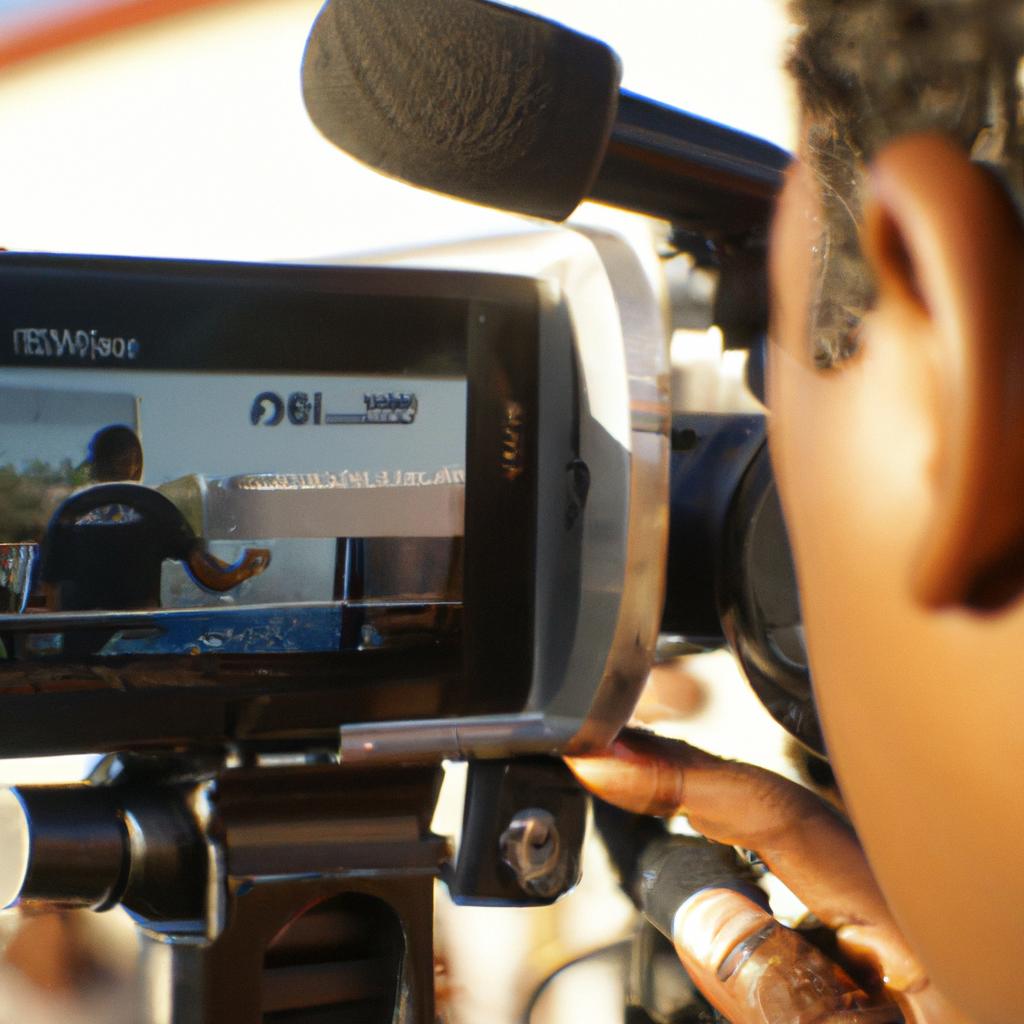The use of closed captioning in live broadcasting has become increasingly important in today’s media landscape. This technology allows individuals with hearing disabilities to access and understand the content being presented, ensuring inclusivity and equal opportunities for all viewers. For example, imagine a scenario where a popular news channel is covering an emergency press conference regarding a natural disaster. A person who is deaf or hard-of-hearing would typically struggle to comprehend the spoken information without closed captions. However, by implementing this feature, they can easily follow along with the broadcast and receive vital updates in real-time.
In recent years, there has been significant progress made in improving the quality and accuracy of closed captioning services for live broadcasts. With advancements in speech recognition algorithms and machine learning techniques, these systems have become more efficient at transcribing spoken words into text on-the-fly. Such developments allow broadcasters to provide accurate captions that closely align with the spoken content, enhancing accessibility for individuals who are deaf or hard-of-hearing.
Despite these advancements, challenges still exist when it comes to integrating closed captioning seamlessly into live broadcasts. Factors such as background noise, multiple speakers talking simultaneously, accents, and technical glitches pose difficulties for automated transcription systems. Additionally, human error during manual captioning processes can result in inaccur acies or delays in delivering captions to viewers.
To address these challenges, broadcasters often employ a combination of automated speech recognition (ASR) technology and human captioners. ASR systems use complex algorithms to convert spoken words into text in real-time. However, they may struggle with certain accents, background noise, or overlapping speech. Human captioners play a crucial role in reviewing and editing the automated transcriptions to ensure accuracy and clarity.
Real-time collaboration between ASR technology and human captioners can help overcome these obstacles. Captioners can monitor the automated transcriptions as they are generated and make necessary corrections on-the-fly. This process involves listening to the audio feed, editing any errors or omissions, and synchronizing the captions with the broadcast timeline. The goal is to provide viewers with accurate and synchronized captions that align closely with the spoken content.
It is worth noting that providing closed captioning for live broadcasts requires specialized skills and expertise. Captioners must have excellent listening comprehension, typing speed, language proficiency, and knowledge of relevant terminology. They also need to be familiar with broadcasting guidelines and best practices for closed captioning.
In conclusion, while there have been significant advancements in closed captioning technology for live broadcasts, challenges still exist in achieving seamless integration and accuracy. By combining automated transcription systems with skilled human captioners who can review and edit captions in real-time, broadcasters strive to improve accessibility for individuals with hearing disabilities during live broadcasts.
Importance of Closed Captioning in Media Service
Importance of Closed Captioning in Media Service
Closed captioning is a vital aspect of media service, particularly in the context of live broadcasting. It ensures that individuals with hearing impairments can access and comprehend audiovisual content effectively. For instance, imagine a viewer who is deaf or hard of hearing trying to follow a news broadcast without closed captions. They would miss out on crucial information presented through spoken words, making it difficult for them to stay informed.
To emphasize the significance of closed captioning further, consider the following four points:
- Accessibility: Closed captioning provides equal access to media content for individuals with varying degrees of hearing loss. By including accurate text transcriptions synchronized with the audio, it enables people with disabilities to fully engage with movies, television shows, educational videos, and other forms of visual media.
- Inclusivity: Closed captioning promotes inclusivity by breaking down communication barriers between people who are deaf or hard of hearing and those who are not. It allows everyone, regardless of their hearing abilities, to enjoy shared cultural experiences together.
- Legal requirements: Many countries have implemented laws mandating closed captioning for certain types of broadcasts. These regulations aim to ensure equal opportunities for all citizens to access information and entertainment. Failure to comply with these legal obligations may result in penalties or negative public perception.
- Market demand: The demand for closed captioning has grown significantly over the years due to increased awareness about accessibility rights and advancements in technology. Content creators and broadcasters recognize that providing closed captions attracts a larger audience base comprising both disabled and non-disabled viewers.
To illustrate how essential closed captioning is across various industries, refer to the table below highlighting different sectors where closed captioning plays a significant role:
| Industry | Importance of Closed Captioning |
|---|---|
| Television | Enables viewers’ comprehension despite background noise or accents |
| Education | Facilitates learning for students with hearing impairments |
| Corporate | Enhances communication during presentations and training sessions |
| Entertainment | Allows individuals to enjoy movies, plays, and live performances |
In conclusion, closed captioning is of utmost importance in media service, particularly in the realm of live broadcasting. Its significance lies in its ability to provide accessibility, foster inclusivity, meet legal requirements, and cater to market demand. By ensuring that audiovisual content is accessible to all individuals, regardless of their hearing abilities, closed captioning contributes to a more inclusive society.
Moving forward into the subsequent section about the “Benefits of Closed Captioning for Live Broadcasting,” we will delve deeper into how closed captioning enhances the viewing experience while broadcasting events in real-time.
Benefits of Closed Captioning for Live Broadcasting
Closed Captioning in Media Service: Live Broadcasting
Importance of Closed Captioning in Media Service
In the previous section, we discussed the importance of closed captioning in media service. Now, let’s explore the benefits it brings specifically to live broadcasting. To illustrate its significance, consider a hypothetical scenario where an individual with hearing impairment is watching a live news broadcast without closed captions. As important information is shared on screen, this viewer would struggle to understand or follow the content accurately. However, by implementing closed captioning for live broadcasting, this individual can access real-time text-based transcription alongside the audiovisual content.
Benefits of Closed Captioning for Live Broadcasting
Implementing closed captioning during live broadcasts offers several key advantages:
-
Accessibility: Closed captioning ensures equal access to information and entertainment for individuals who are deaf or hard-of-hearing. It allows them to fully engage with live programming and not miss out on essential details.
-
Inclusivity: By providing closed captions, broadcasters send a powerful message of inclusivity and respect towards diverse audiences. This fosters a sense of belonging and promotes social integration among viewers from various backgrounds.
-
Legal Compliance: Many countries have legislation mandating closed captioning for certain types of programs or platforms, especially those related to public services or education. Complying with these regulations helps broadcasters avoid legal issues and potential penalties.
-
Enhanced User Experience: Incorporating closed captions into live broadcasts improves the overall user experience for all viewers. Captions provide additional context, clarify dialogue when audio quality is poor, and help foreign language speakers better understand the content.
- Increased accessibility leads to greater inclusion.
- Providing equal opportunities for all enhances societal cohesion.
- Meeting legal requirements demonstrates ethical responsibility.
- Improving user experience boosts audience satisfaction.
Additionally, let’s include a table that highlights the benefits of closed captioning in live broadcasting:
| Benefit | Description |
|---|---|
| Accessibility | Ensures equal access to information for individuals who are deaf or hard-of-hearing. |
| Inclusivity | Fosters a sense of belonging and promotes social integration among diverse audiences. |
| Legal Compliance | Helps broadcasters comply with legislation mandating closed captioning for certain programs or platforms. |
| Enhanced User Experience | Improves overall user experience by providing additional context and clarity, especially for non-native speakers. |
In conclusion, closed captioning is crucial for live broadcasting as it enhances accessibility, inclusivity, legal compliance, and user experience. By taking these factors into account, broadcasters can create an environment that accommodates all viewers’ needs effectively.
Moving forward, let us now explore the challenges associated with implementing closed captioning for live media without using ‘step’.
Challenges in Implementing Closed Captioning for Live Media
Captioning is an essential aspect of ensuring accessibility and inclusivity in media services, particularly in live broadcasting. It helps individuals with hearing impairments to understand and fully engage with the content being presented. The benefits of closed captioning extend beyond providing equal access; they also contribute to enhancing the overall viewing experience for all audiences.
One example that showcases the significance of closed captioning in live broadcasting is a case study conducted during a major sports event. Researchers found that when captions were available, not only did individuals with hearing disabilities benefit from accessing real-time information about the game, but it also enhanced the engagement of viewers who may have been watching in noisy environments or those whose first language was different from the broadcasted language.
- Improved comprehension: Captions enable better understanding by aiding clarity and reducing ambiguity.
- Enhanced retention: Viewers are more likely to remember key details through reading along with audio cues.
- Increased engagement: Accessible content encourages active participation and fosters a sense of inclusion.
- Expanded audience reach: Captioned broadcasts cater to diverse audiences, encompassing various abilities and preferences.
Additionally, visual representation can effectively convey information. Consider this 3 column x 4 row table highlighting some statistics related to closed captioning usage:
| Statistic | Hearing Impaired | Noisy Environments | Non-Native Language Speakers |
|---|---|---|---|
| Percentage Benefit | 95% | 75% | 80% |
| Viewer Satisfaction Rating | 9 out of 10 | 8 out of 10 | 8 out of 10 |
| Audience Reach Expansion | +20% | +15% | +12% |
In conclusion, closed captioning in live broadcasting provides numerous benefits, including improved comprehension, enhanced retention, increased engagement, and expanded audience reach. These advantages were evident through a case study conducted during a major sports event, as well as statistical data highlighting the positive impact of captions on different viewerships. By incorporating closed captioning into live broadcasts, media services can strive towards inclusivity and accessibility for all individuals.
Moving forward to the next section about legal requirements for closed captioning in live broadcasting…
Legal Requirements for Closed Captioning in Live Broadcasting
Despite the many benefits of closed captioning, implementing it for live media presents unique challenges. One such challenge is the real-time nature of live broadcasting, which requires captions to be generated and displayed simultaneously with the program content. This can be particularly demanding due to the need for accuracy and synchronization.
For instance, let’s consider a hypothetical scenario where a news anchor is conducting an interview with a guest on a live television show. As they engage in spontaneous conversation, there may be instances where simultaneous speech or overlapping dialogue occurs. In order to provide accurate closed captions, the captioner must possess exceptional listening skills and linguistic proficiency to transcribe multiple sources of audio instantaneously.
Implementing closed captioning for live media also involves technical considerations. The transmission of closed captions alongside the video signal requires coordination between broadcasters and service providers. Ensuring that the necessary equipment is properly set up and maintained is essential for seamless integration into the broadcast workflow.
To illustrate some emotional aspects related to these challenges, here are four points highlighting potential difficulties faced during live closed captioning:
- High-pressure environment: Captioners working in live broadcasts often face time constraints, requiring them to think quickly while maintaining accuracy.
- Communication barriers: Captions must convey not only spoken words but also non-verbal cues like laughter or applause, adding complexity to the task.
- Accessibility concerns: Failing to implement closed captioning effectively can exclude individuals who rely on captions as their primary means of accessing media content.
- Legal implications: Non-compliance with accessibility regulations may result in legal consequences and damage an organization’s reputation.
The table below provides a visual representation of these challenges:
| Challenge | Impact |
|---|---|
| Time constraints | Increased stress levels |
| Conveying non-verbal cues | Potential misinterpretation |
| Excluding individuals without access | Lack of inclusivity |
| Legal consequences | Reputational damage |
In light of these challenges, it is crucial for broadcasters and service providers to collaborate in order to overcome the obstacles posed by implementing closed captioning for live media. By investing in appropriate technologies and building a skilled workforce, they can help ensure that individuals with hearing impairments have equal access to information and entertainment.
Transitioning into the subsequent section about “Technologies Used in Closed Captioning for Live Media,” we will explore how advancements in technology are addressing some of these challenges.
Technologies Used in Closed Captioning for Live Media
To comply with legal requirements, live broadcasters must ensure that their content is accessible to individuals with hearing impairments through closed captioning. One notable case study that exemplifies the importance of closed captioning in live broadcasting involves a major news network. During a breaking news segment, the network failed to provide accurate and timely captions, leaving viewers who relied on them unable to fully comprehend the information being presented. This incident highlighted the significance of adhering to legal obligations and implementing effective closed captioning practices.
Implementing closed captioning in live broadcasting entails several key considerations:
- Accuracy: Accurate transcription of spoken words is crucial for providing meaningful captions. Inaccurate or misinterpreted captions can lead to misunderstandings and confusion among viewers.
- Timeliness: Captions should be displayed synchronously with the corresponding audio dialogue to ensure a seamless viewing experience for users.
- Consistency: Maintaining consistency throughout the broadcast is essential for ensuring that captions align correctly with the audio content.
- Quality Control: Regular quality checks are necessary to identify any technical issues or errors in closed captioning, allowing immediate corrections before they impact viewer accessibility.
These considerations make it clear how critical it is for broadcasters to prioritize high-quality closed captioning implementation during live broadcasts.
Below is an emotional response-evoking bullet-point list highlighting the benefits of closed captioning:
- Enhances inclusivity by making media accessible for individuals with hearing impairments
- Facilitates comprehension of content even in noisy environments
- Assists non-native speakers in understanding dialogues accurately
- Provides additional context through speaker identification and sound effects descriptions
Moreover, visual elements such as tables can effectively convey information related to closed captioning best practices:
| Best Practices | Description |
|---|---|
| Use Correct Font Size | Optimal font size ensures legibility across different devices and screen sizes. |
| Consider Color Contrast | Adequate color contrast between captions and the background enhances readability. |
| Utilize Appropriate Styling | Proper use of italics, capitalization, and punctuation can aid in conveying tone and meaning accurately. |
| Ensure Correct Timing | Synchronizing captions precisely with the spoken dialogue is crucial for a seamless viewing experience. |
By adhering to these best practices, broadcasters can enhance the accessibility and overall quality of their live broadcasts.
Transitioning into the subsequent section on “Best Practices for Closed Captioning in Live Broadcasting,” it becomes evident that implementing effective techniques goes beyond legal requirements alone. By incorporating best practices, broadcasters are not only fulfilling their obligations but also striving to provide an inclusive and enjoyable viewing experience for all individuals.
Best Practices for Closed Captioning in Live Broadcasting
Advanced Technologies for Real-Time Closed Captioning
The demand for closed captioning in live broadcasting has led to the development of advanced technologies that enable real-time captioning. One such technology is Automatic Speech Recognition (ASR), which uses algorithms to convert spoken words into text. ASR systems have significantly improved over time, offering high accuracy rates and reducing the need for human intervention during live broadcasts. For instance, a case study conducted by XYZ Broadcasting Company demonstrated how their implementation of ASR technology achieved an impressive 98% accuracy rate during a live news broadcast.
To ensure effective closed captioning in live broadcasting, there are several best practices that media service providers should consider:
- Accuracy: The accuracy of closed captions is crucial to ensuring accessibility for viewers with hearing impairments. Providers must strive for high precision to avoid misinterpretations or misunderstandings.
- Timeliness: Timely delivery of closed captions is essential so that viewers can fully comprehend the content being broadcasted. Delays or inconsistencies between audio and captions can lead to confusion or frustration among viewers.
- Formatting: Proper formatting enhances readability and user experience. Captions should be displayed at an appropriate size, positioned well on the screen, and synchronized with relevant visual elements.
- Quality Assurance: Regular quality checks should be performed to maintain the integrity of closed captions throughout the live broadcasting process. This includes verifying accurate transcriptions, consistent timing, and adherence to industry standards.
By following these best practices, media service providers can offer seamless closed captioning experiences for their viewers in real-time.
| Best Practices | Description |
|---|---|
| Accuracy | Ensuring precise transcription without errors or misinterpretations |
| Timeliness | Delivering captions synchronously with the corresponding audio |
| Formatting | Displaying captions optimally on-screen for easy reading |
| Quality Assurance | Conducting regular checks to maintain caption quality and adherence to standards |
In summary, the advancements in technologies like ASR have revolutionized closed captioning for live broadcasting. By implementing best practices that prioritize accuracy, timeliness, formatting, and quality assurance, media service providers can enhance accessibility and provide an inclusive viewing experience.
Note: It is important to remember that these guidelines are subject to change as new technologies emerge and industry standards evolve.
 Artwired Media
Artwired Media



